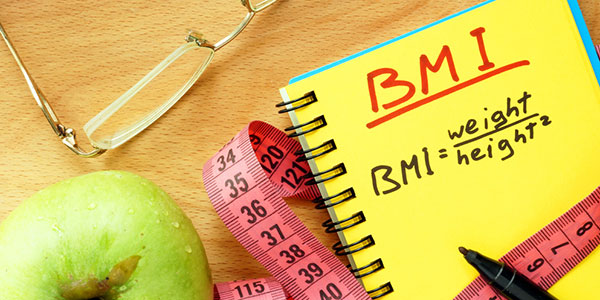What Does BMI Stand For?
What Does BMI Stand For?
BMI stands for body mass index, and that index is how doctors classify weight. Classifying someone as ‘obese’ is not an attempt to label them personally, but instead it is a way for physician’s to assess their patient’s health risks.

What does BMI stand for?
Physicians and researchers use BMI (BMI stands for body mass index) to categorize a person's weight. They don't do this to be mean, instead it gives the physician valuable information about the patient's risk of developing certain diseases. It's not, however, the ideal way to assess someone's weight -- or their health for that matter. So what does BMI actually mean?
Put simply, BMI takes the ratio of a person's height to their weight and makes a nice round number out of it. Healthy BMI's range from 18-25. If you are above or below this range, then your mortality risk (or the risk of you dying!) is higher than someone who has a normal BMI. Classifying someone as 'obese' is not an attempt to label them personally, but instead it is a way for physician's to assess their patient's health risks. BMI stands for body mass index, and that index is how doctors classify weight.
Check out the free diet analysis tool at the bottom of this page to calculate your BMI and get useful weight loss tips from bistroMD.
Overweight individuals have BMI's of 26-30. Because this measurement only takes into account a person's weight on the scale, it becomes a terrible measurement for, say, an athlete who has a lot of lean muscle tissue. In fact, many Olympic competitors and weight lifters are categorized as 'obese' due to the large amount of lean muscle tissue, even though when you observe them, they appear quite lean.
In addition to athletes, BMI is not a good indicator of health in elderly adults either, who may have lost muscle tissue as result of aging and limited mobility. Luckily there are quite a few alternatives to BMI.
Obese individuals fall into the BMI range of 35 and above. There are three difference classes of Obese – namely Obese class I, class II, and class III. These only exist to help doctors assess what health conditions you are risk for due to extra weight.
BMI is not the best way to determine your weight status, and luckily there are other methods.
Measuring your waist circumference is better than BMI at assessing your health status. If most of the weight you carry is localized around your waist or belly rather than your hips, you automatically have an increased risk for developing type 2 diabetes and heart disease. In fact, someone with a normal BMI (in the healthy range of 18-25) can also carry too much weight around their stomach, which automatically increases their risk for these diseases as well!
For women, a waist circumference greater than 35 inches, and for men, a waist circumference greater than 40 inches means you are much more likely to have health problems than if your waist was under those measurements. If you'd like to measure your waist, just stand up and circle a measuring tape around your waist just above your hipbones. Breathe out, and see where the 0 end meets the other part of the tape.
Other alternatives to BMI include using other methods to measure body composition. Body composition just means that your body is composed of certain amounts of fat and muscle, and you can measure that in specific ways. Often, when you measure body composition, the number you get is called percent body fat. You can be a higher percent body fat, or a lower percent body fat. Some of the easier ways to determine your percent body fat include skinfold measurements, which most gyms provide, as well as bioelectric impedance analysis – a handheld device that uses an electric current to assess your body fat percentage.
Some of the more complex ways to determine your body composition - which are much better than BMI at assessing your body composition - include underwater weighing, DXA machine, and a Bod Pod, which all give accurate measurements of your body composition, and can output your body fat percentage.
Regardless of what your BMI is –it's much more important to assess how your clothes are fitting, if your waist circumference is changing, and if you feel energetic when you are losing or maintaining weight. Sometimes, these measures can be even more important to keep tabs on than your weight on the scale! Here's why.
When beginning to exercise and lift weights, often times individuals will gain weight when they first begin. And this is exactly what you don't want to happen, right? But this is the kind of weight you DO want to add. It can be very disheartening when the scale does not budge after a week of exercise. But if you are exercising, it might be that your body is simply rearranging a bit, and your body composition is changing, even though the scale isn't.
-
Amazing Advice On Getting Rid Of Tummy Fat Forever
Do you want to get rid of your excess tu
-
Lose Weight Subconsciously
Sitting on your shoulders is a loaded gun. A weapon. A part of you
-
Natural Weight Loss - The Safe Way To Lose Weight
Are you sick and tired of that extra wei
-
Chosing The Right Diet For You
There are so many different and varied diets floating around today
-
Burn More Calories and Lose Weight with 7 Metabolism Boosting Strategies
It’s the cardinal rule of weight loss—calories in minus calories burne
-
Book Review: The South Beach Diet
This book review is part of a series that covers the topic of Diet
- DON'T MISS
- Do You Should Certainly be an Applicant To Obtain Lipo Suction?
- Lose Weight Tips - Lose Weight Easy by Adjusting Your Food Portion Size
- Want To Feel Happier AND Burn More Calories? Try This!
- Personal Training: 6 Secrets of Award Winning Customer Service
- How to End Sugar Addiction - Detox From Junk Food
- Fast Muscle Gain Training
- Fat Loss Revealed And Helped Many People Who Failed At Loss Weight
- Why Do We Gain Weight?
- Arent You Tired Of Being Fat
- Are All Carbohydrates Bad




